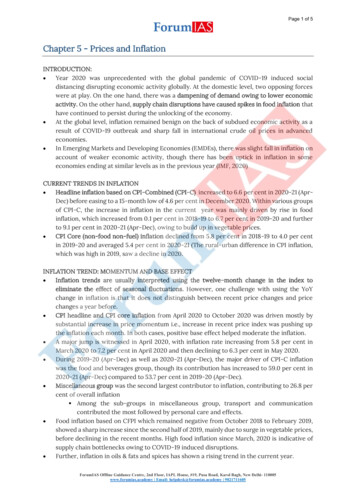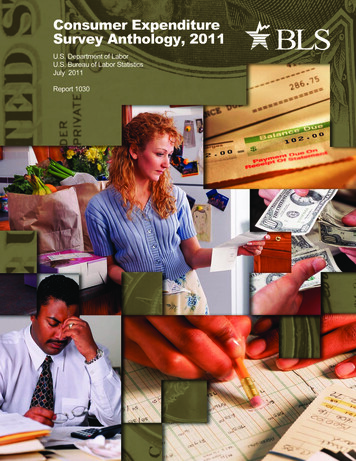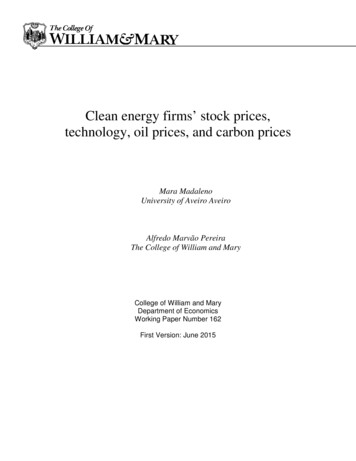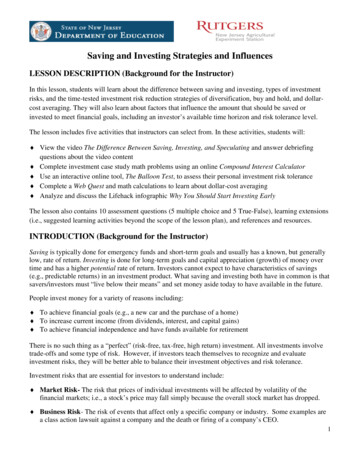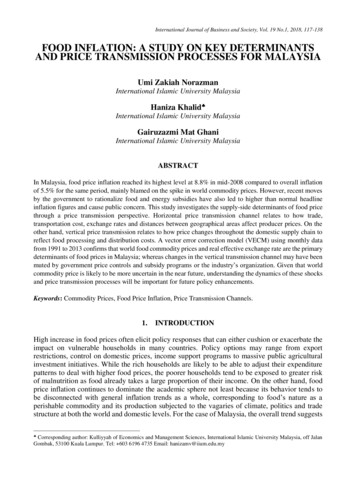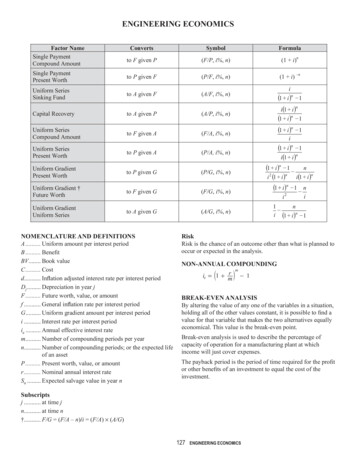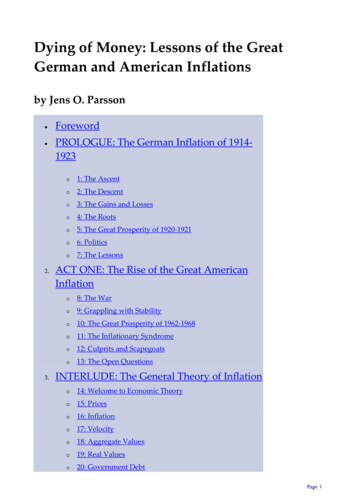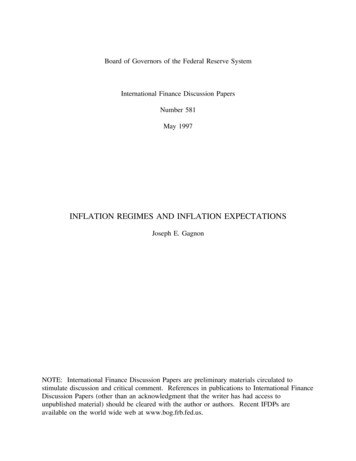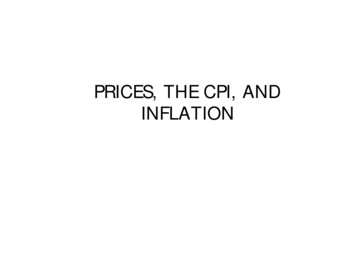
Transcription
PRICES, THE CPI, ANDINFLATION
THE CONSUMER PRICE INDEX (ch. 9)Consumer Price Index (CPI)A measure of the average of the prices paid by urbanconsumers for a fixed market basket of consumergoods and services.
22.1 THE CONSUMER PRICE INDEX Reading the CPI NumbersThe CPI is defined to equal 100 for a period called thereference base period.Reference base periodA period for which the CPI is defined to equal 100.Currently, the reference base period is 1982-1984.
22.1 THE CONSUMER PRICE INDEXIn August 2002, the CPI was 181.The average of the prices paid by urban consumers fora fixed market basket of consumer goods and serviceswas 81 percent higher in September 2002 than it wason the average during 1982-1984.
22.1 THE CONSUMER PRICE INDEX Constructing the CPIThree stages: Selecting the CPI basket Conducting the monthly price survey Calculating the CPI
22.1 THE CONSUMER PRICE INDEX1. The CPI BasketMake the relative importance of the items in the CPIbasket the same as in the budget of an average urbanhousehold.CPI-U Measures the average price paid by all urbanhouseholds.CPI-W Measures the average price paid by urban wageearners and clerical workers.
22.1 THE CONSUMER PRICE INDEXFigure 22.1 shows the CPI basket.This shopping cart is filled with the items that an averagehousehold buys.
22.1 THE CONSUMER PRICE INDEX2. The Monthly Price SurveyEach month, BLS employees check the prices of the80,000 goods and services in the CPI basket in 30metropolitan areas.
22.1 THE CONSUMER PRICE INDEX3. Calculating the CPIThe CPI calculation has three steps: Find the cost of the CPI basket at base periodprices. Find the cost of the CPI basket at current periodprices. Calculate the CPI for the base period and thecurrent period.
22.1 THE CONSUMER PRICE INDEXTable 22.1 shows the consumer price index: a simplifiedCPI calculation.
22.1 THE CONSUMER PRICE INDEXCPI Cost of CPI basket at current period prices x 100Cost of CPI basket at base period pricesFor 2000, the CPI is: 50 50x 100 100For 2003, the CPI is: 70 50x 100 140
22.1 THE CONSUMER PRICE INDEX Measuring InflationInflation rateThe percentage change in the price level from one yearto the next.Inflation rate CPI in current year - CPI in previous year x 100CPI in previous yearInflation rate 140 - 120 x 100 16.7 percent120
22.1 THE CONSUMER PRICE INDEXFigure 22.2 shows the CPI in part (a) and the inflation ratein part (b).
22.1 THE CONSUMER PRICE INDEXIn part (a), the price level has increased every year. Therate of increase was rapid during the early 1980s andslower during the 1990s.
22.1 THE CONSUMER PRICE INDEXIn part (b), the inflation rate was high during the early1980s, but low during the 1990s.
Monthly Price Changes, 1918-2003
22.2 THE CPI AND THE COST OF LIVING The Biased CPIThe main sources of bias in the CPI are: New goods bias Quality change bias Commodity substitution bias Outlet substitution bias
22.2 THE CPI AND THE COST OF LIVINGNew Goods Bias New goods do a better job than the old goods thatthey replace, but cost more. The arrival of new goods puts an upward bias intothe CPI and its measure of the inflation rate.Quality Change Bias Better cars and CD players cost more than theversions they replace. A price rise that is a payment for improved qualityis not inflation but might get measured as inflation.
22.2 THE CPI AND THE COST OF LIVINGCommodity Substitution Bias If the price of beef rises faster than the price ofchicken, people buy more chicken and less beef. The CPI basket doesn’t change to allow for theeffects of substitution between goods.Outlet Substitution Bias If prices rise more rapidly, people use discountstores more frequently. The CPI basket doesn’t change to allow for theeffects of outlet substitution.
22.2 THE CPI AND THE COST OF LIVING The Magnitude of the BiasThe Boskin Commission estimated the bias to be 1.1percentage points per year.If the inflation rate reported is 3.1 percent, the trueinflation rate is probably 2.0 percent.To reduce the bias, the BLS has decided to increasethe frequency of its Consumer Expenditure Survey andto revise the CPI basket every two years.
22.3 NOMINAL AND REAL VALUES Dollars and Cents at Different DatesTo compare dollar amounts at different dates, we needto know the CPI at those dates.Convert the price of a 2-cent stamp in 1902 into its 2002equivalent:Price of stamp in 2002 dollars Price of stamp in 1902 dollars xCPI in 2002CPI in 1902 2 cents x180.39 40 cents
22.3 NOMINAL AND REAL VALUES Babe Ruth’s SalaryBabe’s Salary in 1931 80,000How Much Would the Babe have made in 2001?
22.3 NOMINAL AND REAL VALUES Babe Ruth’s SalaryBabe’s Salary in 1931 80,000How Much Would the Babe have made in 2001?Salary in 2001 dollars 80,000 xSalary in 1931 dollars x17715.2 931,578CPI in 2001CPI in 1931
22.3 NOMINAL AND REAL VALUES Nominal and Real Values in MacroeconomicsMacroeconomics makes a big issue of the distinctionbetween nominal values and real values: Nominal GDP and real GDP Nominal wage rate and real wage rate Nominal interest rate and real interest rateWe studied the distinction between and calculation ofnominal and real GDP in Chapter 5. Here, we’ll look atthe other two.
22.3 NOMINAL AND REAL VALUES Nominal and Real Wage RatesNominal wage rateThe average hourly wage rate measured in currentdollars.Real wage rateThe average hourly wage rate measured in the dollarsof a given reference base year.
22.3 NOMINAL AND REAL VALUESTo calculate the real wage rate, we divide the nominalwage rate by the CPI and multiply by 100.That is:Nominal wage rate in 2002Real wage rate in 2002 Real wage rate in 2002 CPI in 2002 14.76180.3x 100 8.19The 8.19 amount is in 1982-1984 dollars.x 100
22.3 NOMINAL AND REAL VALUESFigure 22.4 showsnominal and real wagerates: 1972–2002.The nominal wage ratehas increased every yearsince 1972.The real wage ratedecreased during the late1970s and increasedduring the late 1990s.
22.3 NOMINAL AND REAL VALUES Nominal and Real Interest RatesNominal interest rateThe percentage return on a loan expressed in dollars.Real interest rateThe percentage return on a loan expressed inpurchasing power—the nominal interest rate adjustedfor the effects of inflation.Real interest rate Nominal interest rate – Inflation rate
22.3 NOMINAL AND REAL VALUESFigure 22.5 shows realand nominal interestrates: 1972–2002.During the 1970s,the real interest ratebecame negative.The nominal interestrate increased duringthe high-inflation 1980s.
13.3 NOMINAL GDP VERSUS REAL GDP Calculating Real GDPReal GDPThe value of the final goods and services produced in agiven year when valued at constant prices.Nominal GDPThe value of the final goods and services produced in agiven year valued at the prices that prevailed in that sameyear.The first step toward calculating real GDP is to calculatenominal GDP.
13.3 NOMINAL GDP VERSUS REAL GDPTo calculate nominal GDP in 2002, sum the expenditureson apples and oranges in 2002.Expenditure on apples 100 apples x 1 100Expenditure on oranges 200 oranges x 0.50 100Nominal GDP in 2002 100 100 200
13.3 NOMINAL GDP VERSUS REAL GDPTo calculate nominal GDP in 2003, sum the expenditureson apples and oranges in 2003.Expenditure on apples 160 apples x 0.50 80Expenditure on oranges 220 oranges x 2.25 495Nominal GDP in 2003 80 495 575
13.3 NOMINAL GDP VERSUS REAL GDPTraditional method of calculating real GDP in 2003: Sumthe expenditures on the 2003 quantities at 2002 prices.Expenditure on apples 160 apples x 1.00 160Expenditure on oranges 220 oranges x 0.50 1102003 quantities at 2002 prices 160 110 270Traditional method real GDP in 2003 is 270 (2002 dollars)
13.3 NOMINAL GDP VERSUS REAL GDPWhen we value 2003 production in 2002 prices,production increased from 200 to 270 (2002 dollars),an increase of 35 percent.The new method of calculating real GDP uses thispercentage increase but combines it with another one—the percentage increase in production when we use theprices of 2003 to compare 2002 and 2003. – (You don’tneed to know this for the exam)
The Costs of Inflation The costs of inflation are less obvious thanthose of unemployment, yet people certainlyfear it. Inflation and Real Wages: Inflation does nottypically erode real wages in the US, becauseincreases in nominal wages compensate for therising prices.
0001950196019551970196519801975YearCopyright 2000 by Harcourt, Inc. All rights reserved.199019851995Percentage Change in PricesPercentage Change in WagesRATES OFCHANGE OFWAGES ANDPRICESIN THE U.S.,1948-199812
The Costs of Inflation The Illusion of Traditional “Fair” Prices:Inflation does not necessarily lead to unfairprices. The Importance of Relative Prices: Inflation isnot usually to blame when some goods becomemore expensive relative to others.
Inflation as a Redistributor of Income andWealth Because inflation does not proceed evenly, itredistributes income and wealth in arbitrary,unfair ways. It systematically discriminates against peopleon fixed incomes, and it may favor borrowers atthe expense of lenders.
Real versus Nominal Interest Rates Nominal rate of interest Real interest rate expected rate of inflation Real rate of interest Nominal interest rate - expected rate of inflation
Real versus Nominal Interest Rates Inflation that is accurately anticipated need notredistribute wealth between borrowers andlenders.– The nominal interest rate will include an adequateinflation premium, above the real interest rate. If the actual inflation rate turns out to bedifferent from the expected rate unanticipatedredistribution will occur.
Inflation Distorts Measurements Many laws and regulations that were designedfor an inflation-free economy malfunction wheninflation is high. These costs of inflation are not purelyredistributive. Society as a whole loses when mutuallybeneficial transactions are prohibited bydysfunctional legislation.
Examples of Extreme Inflation –HyperinflationInflation Rates over time for Select 98519881991199419972000Year20Percent change in the CPI (1995 100)BoliviaBrazilFranceIsraelUnited States
Examples of Extreme Inflation –HyperinflationInflation Rates over time for Select 9881991199419972000Year1000-500Percent change in the CPI (1995 100)BoliviaBrazilFranceIsraelUnited States
Examples of Extreme Inflation –HyperinflationInflation Rates over time for Select 791982198519881991199419972000Year10000Percent change in the CPI (1995 100)BoliviaBrazilFranceIsraelUnited States
Inflation Distorts MeasurementsExamples of Inflation Distortions Confusing real and nominal interest rates– Hides the true economic cost of borrowing money.– Many Americans viewed the 12% mortgage interestrates that banks charged in 1980 as scandalouslyhigh while they saw the 7% mortgage rates of 1998as a great bargain.– In truth, however, the real interest rate in 1998(about 5%) was well above the bargain-basementreal rates in 1980 (about 2%).
Inflation Distorts MeasurementsOther Costs of Inflation The uncertainty created by inflation may inhibitlong-term contracts. Inflation may impose real costs on shoppers,whose level of information about relative pricesdeteriorates.
Inflation Distorts MeasurementsThe Costs of Low versus High Inflation Inflation creates fewer social problems if– It is low rather than high.– It is steady (and therefore relatively predictable)rather than variable.
Percentage Inflation RateU.S. INFLATION RATE, 1870-1998WorldWar I2520WorldWar IIPostwaradjustmentInflationof the 1970sDisinflationof the 1980sPre-1940151050-5-10Post-Civil WardeflationPostwardeflationGreatDepressionVietnam WarinflationPost-1950-151870 1880 1890 1900 1910 1920 1930 1940 1950 1960 1970 1980 1990 2000YearCopyright 2000 by Harcourt, Inc. All rights reserved.
Growth Rate of Real GDPTHE GROWTH RATE OF REAL GDP,U.S., adprosperityRoaringTwentiesWorldWar IIKoreanWarWorldWar IExpansionof 1960s10Expansionof 1980s50-5-10-15Depressionof 1890sPostwardepressionPanicof n1982-83Recession1990-91RecessionPost-1950-201870 1880 1890 1900 1910 1920 1930 1940 1950 1960 1970 1980 1990 2000YearCopyright 2000 by Harcourt, Inc. All rights reserved.
Real versus Nominal Interest Rates Inflation that is accurately anticipatedneed not redistribute wealth between borrowers and lenders. - The nominal interest rate will include an adequate inflation premium, above the real interest rate. If the actual inflation rate turns out to be different from the expected rate unanticipated


